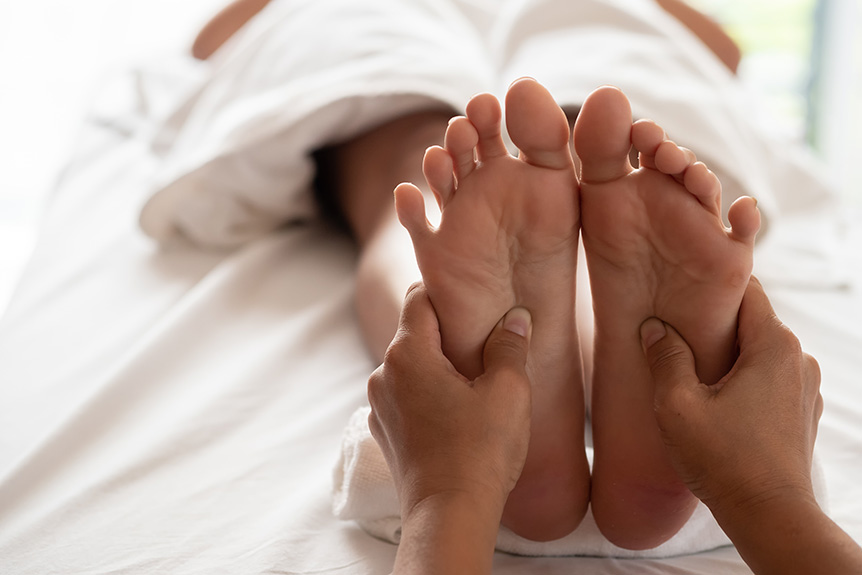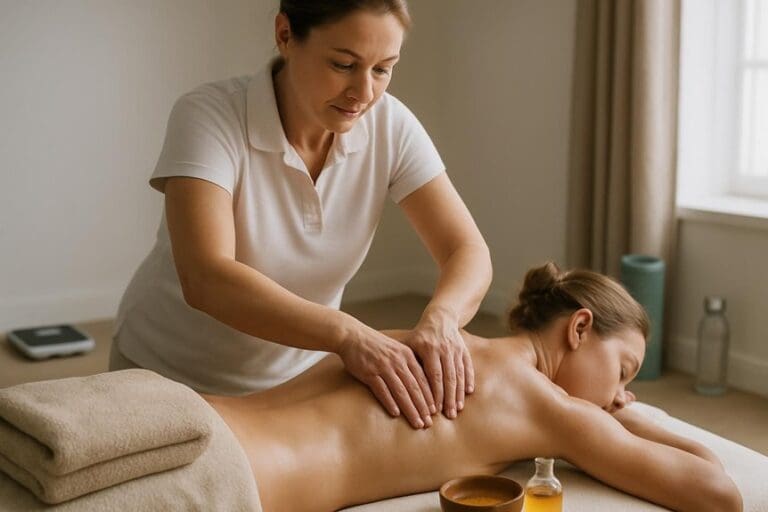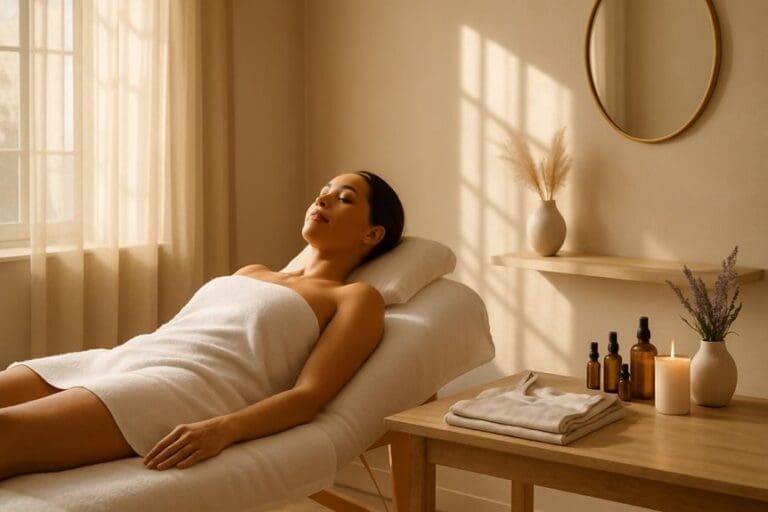It targets kidney, ureter, and bladder reflex zones on the feet and hands using graded pressure and thumb-walking. Evidence suggests short‑term benefits in relaxation, stress reduction, and modest blood pressure lowering, which may indirectly aid fluid balance and sleep. However, studies show inconsistent or negligible effects on renal markers such as eGFR, creatinine, and urea. It is complementary, not a substitute for medical care. Safety screening and GP advice are essential for kidney disease. Further details explain techniques, safety, and integration.
Understanding This Therapy and the Kidney Reflex Points
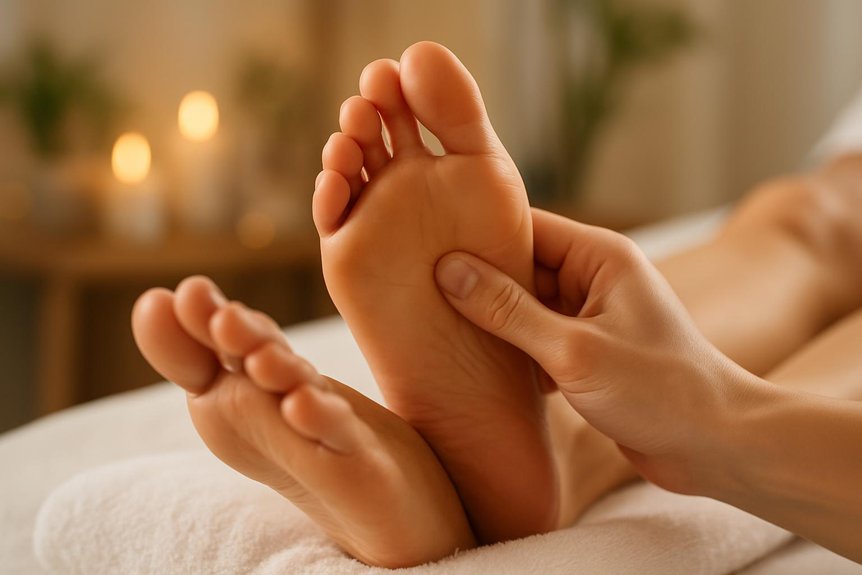
Why does reflexology focus on kidney reflex points? Within it’s somatotopic maps, the kidney reflex zones are typically located along the medial arch of each foot and a corresponding area on the palms.
Practitioners apply graded pressure to these loci using thumb-walking and static compression, monitoring tissue texture, tenderness, and client feedback. The approach is noninvasive and aims to modulate autonomic tone, promote relaxation, and support perceived bodily balance.
At Spa & Massage clinics in London, therapists deliver the massage with clear boundaries: it is a complementary modality, not a substitute for nephrology care.
Sessions are structured, time-bound, and adapted to client sensitivity. Practitioners use hypoallergenic oils sparingly for glide control, document responses objectively, and maintain gentle, attentive pacing to cultivate comfort, trust, and a calm, contained intimacy.
Aromatherapy massage is another relaxation and healing technique sometimes combined with zone therapy to further enhance the client’s sense of wellbeing.
How It May Support Kidney Health
How might this contribute to kidney health? Practitioners propose that precise stimulation of renal, ureteric, and bladder reflex zones on the feet may modulate autonomic tone, encourage peripheral circulation, and support lymphatic return—factors relevant to fluid balance and perceived pelvic comfort.
While not a treatment for renal disease, this therapy may ease stress-related sympathetic arousal that can influence blood pressure regulation, sleep quality, and adherence to self-care.
At Spa & Massage in London, therapists apply calibrated pressure, paced breathing guidance, and gentle fascial holds to promote relaxation without overloading sensitive tissues.
Sessions are adapted for blood pressure variability and oedema, with careful contraindication screening.
Clients are advised to hydrate, avoid excessive diuretics post-session, and monitor personal responses, integrating reflex therapy alongside medical guidance and lifestyle measures.
What the Research Says About This Therapy and Renal Function
Building on proposed mechanisms, the empirical literature offers cautious support for it’s adjunctive value while underscoring clear limitations. Small randomized and quasi-experimental studies report short-term reductions in perceived stress, systolic blood pressure, and pain, with occasional improvements in sleep—factors that can indirectly ease renal workload.
Limited trials in chronic kidney disease and hemodialysis populations suggest transient gains in quality of life and anxiety reduction; however, effects on eGFR, serum creatinine, urea, and proteinuria are inconsistent or negligible.
Methodological constraints persist: modest sample sizes, heterogeneity of protocols, variable reflex maps, inadequate blinding, and short follow-up. Current evidence positions this therapy as a supportive, nonpharmacological intervention for comfort and stress modulation, not a replacement for nephrology care.
At Spa & Massage, therapists integrate this therapy conservatively—aligned with medical guidance and client goals.
Signs You Might Benefit From Reflex Therapy for Kidney Support
Individuals may consider this as an adjunct for kidney support when experiencing stress-related symptoms, sleep disturbance, mild lower back discomfort, fluid retention in the ankles or feet, or elevated blood pressure controlled under medical care.
In clinical practice at Spa & Massage, these presentations often coincide with autonomic dysregulation, perceived fatigue, and a sense of heaviness.
Clients who notice nocturia, mild bloating, or sensitivity over plantar kidney reflex points may also seek evaluation.
It is not a treatment for kidney disease; rather, it may assist with relaxation, perceived tension reduction, and sleep quality—factors that can indirectly support wellbeing.
Red flags—acute flank pain, fever, persistent oedema, or uncontrolled hypertension—require medical assessment.
Our therapists conduct brief screening, adapt pressure, and coordinate care alongside clients’ clinicians.
Techniques Our Therapists Use for Kidney and Urinary Reflex Zones
At Spa & Massage, therapists first identify kidney reflex points along the medial arch of the feet and urinary tract points near the heel and around the ankle using anatomical landmarks and client feedback.
They apply controlled pressure with thumb-walking to achieve consistent, graded stimulation while monitoring tissue response and comfort thresholds.
Sessions conclude with soothing finishing strokes to modulate autonomic tone, reduce post-treatment tenderness, and support circulatory relaxation.
Locating Kidney Reflex Points
How are kidney and urinary reflex zones precisely identified during a massage session? Clinicians at Spa & Massage map the foot using established charts and palpatory landmarks.
The kidney reflex is located on the plantar medial arch, approximately at the junction of the medial third and central third, inferior to the navicular region; the ureter reflex tracks distally toward the calcaneus; the bladder reflex sits centrally on the plantar heel.
Identification depends on visual inspection for edema or discoloration, temperature asymmetry, and tactile assessment for nodularity, taut bands, or pinpoint tenderness.
Therapists confirm symmetry by comparing contralateral points and adjust for foot morphology, prior injury, or orthotic use.
Clear communication ensures comfort while therapists document findings to inform a coherent, client-specific zone therapy plan.
Pressure and Thumb-Walking
While maintaining client comfort and tissue safety, therapists at Spa & Massage apply graded, perpendicular pressure and controlled thumb-walking to the kidney, ureter, and bladder reflex zones.
Pressure is introduced slowly to engage mechanoreceptors without provoking guarding; load is modulated by tissue response and client feedback.
Thumb-walking proceeds in short, contiguous increments, keeping interphalangeal joints neutral to deliver consistent, focal stimulation along mapped reflex pathways.
Sequences typically progress medial to lateral across the plantar kidney zone, then trace the ureter line toward the calcaneal border, concluding over the bladder reflex inferiorly.
Pace remains unhurried to foster autonomic downregulation.
Clinicians monitor skin tone, local warmth, and tenderness thresholds, adjusting depth accordingly.
This measured approach reflects Spa & Massage’s clinical standards and intimacy-minded care.
Soothing Finishing Strokes
Why conclude a zone therapy sequence without consolidating neural downregulation and tissue ease? At Spa & Massage, therapists finish kidney and urinary reflex work with gentle, rhythmic effleurage across the plantar arch, followed by slow transverse stroking over the medial midfoot (kidney zone) and proximal heel (bladder/ureter zones).
Pressure is light-to-moderate, sustained, and uniform—sufficient to engage cutaneous mechanoreceptors while avoiding nociceptive activation.
They often apply warm, hypoallergenic oil to reduce friction and permit fluid stroke continuity.
Terminal holds—still contact at the solar plexus reflex and around the ankle retinaculum—promote parasympathetic dominance, lowering heart rate and perceived tension.
Long proximal-to-distal sweeps drain residual irritability, mirroring lymphatic flow principles.
Clients are encouraged to breathe diaphragmatically; synchronized exhalation with each stroke amplifies relaxation and integrates prior therapeutic input.
What to Expect in a Reflex Therapy Session at Spa & Massage
A typical zone therapy session at Spa & Massage begins with a brief health consultation to identify goals, contraindications, and pressure preferences, followed by a seated or reclined treatment focused primarily on the feet (and, when indicated, hands or ears).
The therapist maps reflex zones, then applies graded pressure using thumb-walking, hook-and-backup, and pivot techniques.
Specific attention is given to the renal, ureter, and bladder reflex areas to support relaxation and circulatory efficiency relevant to kidney health.
Sessions last 30–60 minutes, with continuous feedback to calibrate intensity and sustain comfort.
Clinics in Crouch End, Bayswater, Chiswick, Earl’s Court, Belsize Park, and Richmond maintain a quiet, temperature-controlled setting.
Neutral, hypoallergenic lotion is used to optimize glide without obscuring tactile sensitivity.
Post-session, therapists provide tailored self-care guidance and hydration advice.
Safety Considerations and When to Consult Your GP
Following the structured approach outlined for a typical zone therapy session, attention now turns to safety parameters and indications for medical consultation.
Spa & Massage positions zone therapy as a supportive modality, not a substitute for nephrology care. Clients with chronic kidney disease, diabetes, uncontrolled hypertension, anticoagulation therapy, peripheral neuropathy, active skin infections, recent surgery, or pregnancy should seek GP guidance before treatment.
Any new oedema, flank pain, haematuria, fever, or sudden changes in urine output warrants prompt medical review.
Therapists at Spa & Massage adapt pressure, avoid inflamed or ulcerated areas, and cease if pain, dizziness, or nausea occurs.
Hydration is encouraged within normal limits; excessive fluid intake is discouraged in fluid-restricted patients.
Medication regimens are never altered based on zone therapy response; coordination with a GP safeguards continuity of care.
Aftercare Tips to Maximise Benefits for Kidney Support
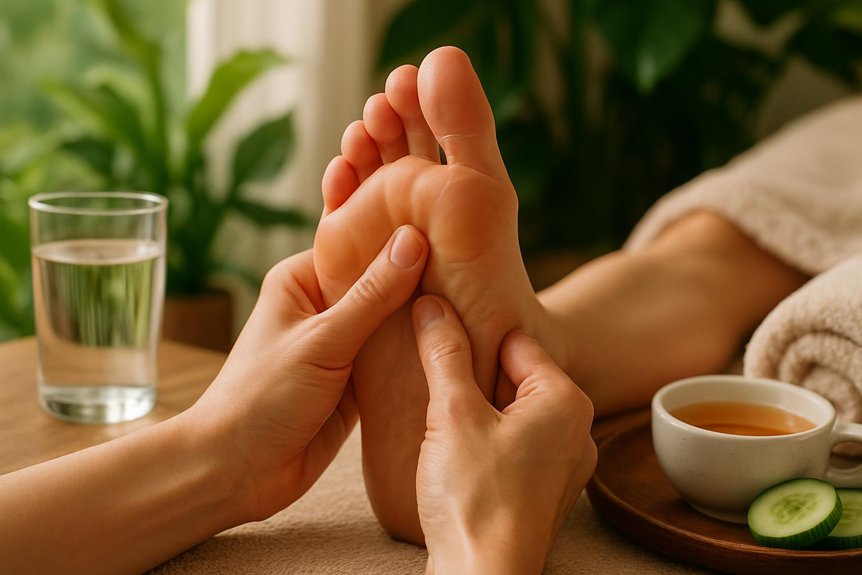
Although zone therapy is non-invasive, structured aftercare enhances physiological recovery and potential renal-supportive effects. At Spa & Massage, therapists advise gentle hydration: 300–500 ml water over two hours post-session to support circulatory clearance without overloading fluid-sensitive individuals.
Light walking (5–10 minutes) maintains peripheral perfusion and mitigates post-treatment lethargy. Warmth applied to feet—such as a short epsom-salt foot soak—can lower sympathetic tone and ease residual tenderness.
Clients are encouraged to avoid alcohol and high-sodium meals for 12–24 hours, as these may counteract fluid balance objectives. Sleep hygiene—dim lighting, earlier bedtime—optimises parasympathetic recovery.
Monitoring urine colour and frequency offers simple, non-invasive feedback; marked changes or discomfort warrant GP advice.
In our clinics, therapists recommend spacing sessions 5–10 days apart and documenting responses to personalise pressure, duration, and foot-zone focus.
How to Integrate Foot Pressure Therapy With a Holistic Wellness Plan
Integrating zone therapy into a holistic kidney-support plan works best when coordinated with medical care, ensuring alignment with diagnoses, medications, and renal function monitoring. Spa & Massage therapists encourage clients to share treatment goals and contraindications, then schedule zone therapy alongside clinician-directed strategies such as blood pressure control, hydration guidance, and nutrition plans.
Daily self-care routines—foot self-massage on kidney and adrenal reflex points, gentle mobility, stress-reduction breathing, and sleep regularity—reinforce treatment effects and support homeostasis.
Coordinating With Medical Care
A coordinated plan aligns zone therapy with a patient’s established medical care, ensuring safety, appropriate timing, and realistic goals.
Spa & Massage advises clients to share renal diagnoses, medications, recent labs (eGFR, creatinine, electrolytes), and symptom patterns with therapists before sessions. This enables appropriate pressure modulation, avoidance of contraindicated areas during acute flare-ups, and realistic session frequency.
With clinician consent, therapists at Spa & Massage document treatment aims—stress modulation, sleep quality, peripheral edema monitoring—and track outcomes using brief symptom scales.
Red flags prompting medical escalation include rising edema, uncontrolled blood pressure, dyspnea, flank pain, or sudden weight gain.
Communication is discreet and client-led; written summaries can be provided for GPs or renal teams.
Hydration guidance is tailored to medical advice, not routine zone therapy norms.
Daily Self-Care Routines
How can zone therapy be structured into a kidney-friendly daily routine? A practical framework includes 10–15 minutes of self-zone therapy on the feet each morning, focusing on the kidney, ureter, and bladder reflex zones (medial plantar arch and heel), using gentle, progressive pressure.
Hydration should follow, aligning with the individual’s clinical fluid guidance. Evening routines can include diaphragmatic breathing and a brief foot sequence to modulate autonomic tone and promote sleep.
At Spa & Massage, therapists advise two clinic sessions per week during initiation, then weekly maintenance, complemented by home care. Clients are guided to pair zone therapy with sodium-aware nutrition, moderate walking, and stress-reduction practices.
Skin integrity checks, pain thresholds, and medical contraindications are observed. A simple journal—symptoms, sleep, energy, and urination patterns—supports feedback and precise adjustments.
Conclusion
In summary, zone therapy may serve as a calm undercurrent—supporting relaxation, circulation, and autonomic balance that can indirectly benefit kidney health. Evidence remains limited and heterogeneous; therefore, zone therapy should complement, not replace, medical care. Clients can expect targeted pressure to renal, ureteral, and bladder reflex zones, with protocols tailored to safety and comorbidities. When integrated with clinician-guided nutrition, hydration, sleep, stress management, and exercise, zone therapy offers a gentle adjunct for wellbeing. Always consult a GP for kidney symptoms or diagnosed renal disease.
